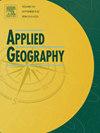The impact of relatedness and unrelatedness on breakthrough innovation in China: Examining the role of complementary interregional linkages
IF 5.4
2区 地球科学
Q1 GEOGRAPHY
引用次数: 0
Abstract
This study discusses the effects of local knowledge base and complementary interregional linkages on regional breakthrough technological development. The empirical analysis takes China as a case study, and the data are 4.12 million patents for 132 technologies in 275 Chinese cities from 2000 to 2020. The study finds that: (1) China's breakthrough innovations exhibit spatially polarized patterns of uneven development, and the technological focus has transitioned from traditional industrial sectors to technology-intensive and emerging strategic industries. (2) Technological relatedness exerted a positive influence on both the entry and growth stage of breakthrough innovations.Conversely, technological unrelatedness facilitates the growth of breakthrough technologies in established technological fields, yet exerts no significant effect on their entry into novel technological fields. Moreover, the effects of technological relatedness and unrelatedness on breakthrough innovations are significantly city-specific. (3) While interregional complementary linkages play a pivotal role in fostering breakthrough innovation formation and development, their interaction with technological unrelatedness exerts a suppressive influence on the technological growth of breakthrough innovations in established fields. This findings provide critical policy implications for nurturing breakthrough technologies in underdeveloped regions, not only within China but also across the global landscape.
关联度与非关联度对中国突破性创新的影响——基于互补区域间联系作用的检验
本研究探讨了地方知识基础和互补的区域间联系对区域突破性技术发展的影响。实证分析以中国为例,数据为2000 - 2020年中国275个城市132项技术的412万项专利。研究发现:(1)中国突破性创新呈现不平衡发展的空间极化格局,技术重心由传统产业向技术密集型和新兴战略产业转移;(2)技术关联度对突破性创新的进入阶段和成长阶段均有正向影响。相反,技术不相关性促进了突破性技术在既定技术领域的成长,但对其进入新技术领域没有显著影响。此外,技术相关性和非相关性对突破性创新的影响具有显著的城市特异性。(3)区域间互补联系在促进突破性创新的形成和发展中发挥着关键作用,但与技术不相关的相互作用对既有领域突破性创新的技术增长具有抑制作用。这一发现为在不发达地区培育突破性技术提供了重要的政策启示,不仅在中国,而且在全球范围内。
本文章由计算机程序翻译,如有差异,请以英文原文为准。
求助全文
约1分钟内获得全文
求助全文
来源期刊

Applied Geography
GEOGRAPHY-
CiteScore
8.00
自引率
2.00%
发文量
134
期刊介绍:
Applied Geography is a journal devoted to the publication of research which utilizes geographic approaches (human, physical, nature-society and GIScience) to resolve human problems that have a spatial dimension. These problems may be related to the assessment, management and allocation of the world physical and/or human resources. The underlying rationale of the journal is that only through a clear understanding of the relevant societal, physical, and coupled natural-humans systems can we resolve such problems. Papers are invited on any theme involving the application of geographical theory and methodology in the resolution of human problems.
 求助内容:
求助内容: 应助结果提醒方式:
应助结果提醒方式:


